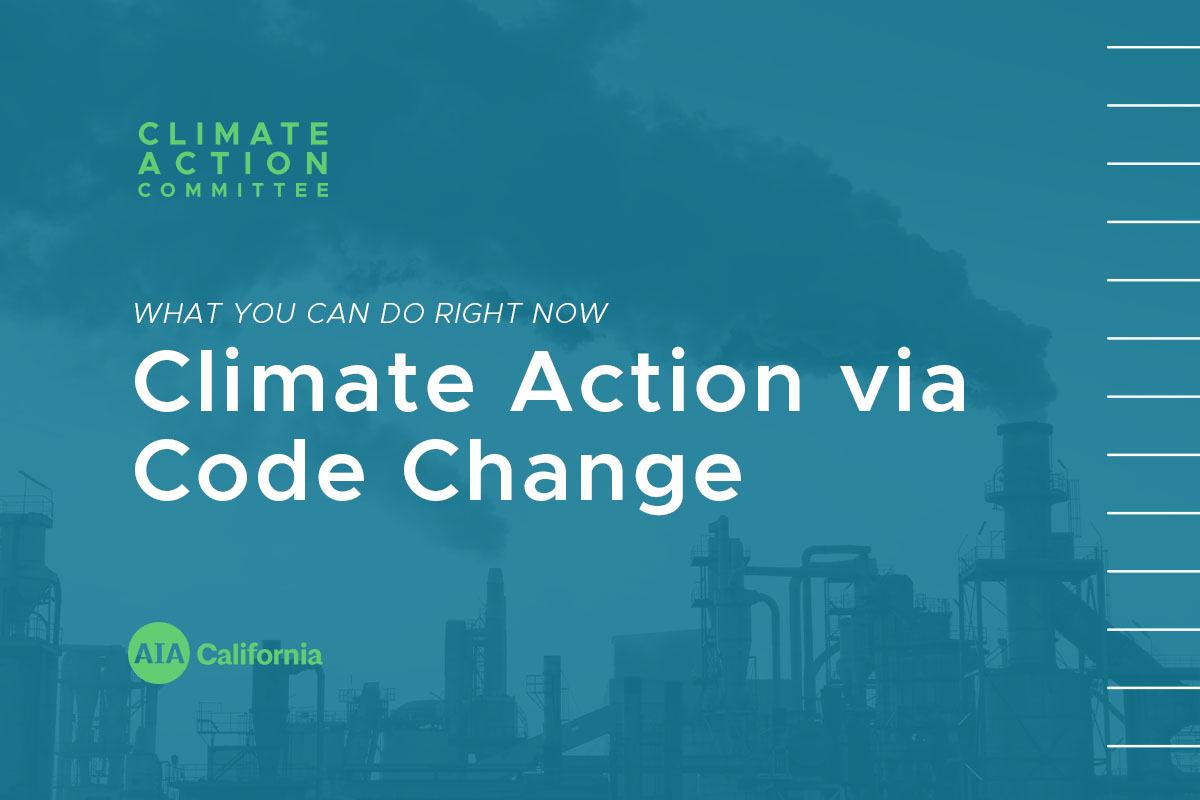
AIA California has made environmental stewardship and climate action central to its strategy and actions. Climate change requires urgent attention, a perspective that is supported by the fact that 1700 + governments around the world that have declared a climate emergency.[1] Considered through this lens, even something as seemingly mundane as code development takes on new importance. This shift was presaged in 2018, when the AIA’s Blue Ribbon Panel for Codes and Standards issued a groundbreaking report that outlines a bold new vision of building codes and standards as valuable design tools for a resource constrained and climate challenged future.[2]
Until recently, this connection between codes and climate action may have seemed somewhat abstract. Code development follows a step by step, carefully meticulous path; as a result, code change tends to be slow, incremental and very fine grained. Broad sweeping moves that might seem best suited for the rapidly escalating climate emergency are not typically part of code development. On the other hand, the code and regulatory environment impacts every building project from new to retrofit, from small to large, so a shift of the entire building industry toward a low and zero carbon framework by definition must intersect with code and regulatory development. In 2019, AIA California expanded its climate action agenda to address code changes. Two bold code change petitions were submitted to California’s Building Standards Commission on behalf of AIA’s 11,000 architect and allied professional members. In fall 2020, these two code changes began the long process of vetting, hearings, debate and refinement that will lead to the 2022 California Building Code. Following is a brief summary of these proposals.
AIA CA Code Change Petitions for the 2022 California Building Code ZEROcode integration into CalGreen: Developed by the nonprofit Architecture 2030 organization – a world leader in climate action innovation – the ZEROcode has recently been made part of the International Building Code’s Energy Conservation Code for 2022 as an optional appendix. AIA California has worked with Architecture 2030 on the creation of a California specific version of the ZEROCode. We have petitioned the California Building Standards Commission to make this a part of California’s codes for commercial construction via the 2022 California Green Buildings Standards Code (CalGreen). As proposed, this would be California’s first zero carbon compliance tool available as an option for local adoption.
Amendment of the California Existing Building Code to incorporate all three compliance paths that exist in the 2022 International Existing Building Code. The International Existing Building Code is unique among the ICC national codes in having a focus on flexibility, presenting users with three compliance paths from which to choose. Each of these paths — Prescriptive, Work Area, and Performance — lead to safe, code compliant buildings. Their differences allow design professionals to match the code path to the unique circumstances a particular existing building challenge can present. Like all ICC Codes, the IEBC has been developed over many years in a national open, transparent, consensus environment. Thus, its provisions are well vetted and are already in use across the United States. The California Existing Building Code does not include these options. This lack of code flexibility in California makes reuse and retrofit of our existing building stock less feasible due to higher costs and greater uncertainty. It also deprives us some of the benefits that come from updating, reusing and retrofitting existing buildings. AIA California is advocating for expansion of the CEBC to include all of IEBC’s provisions. This will encourage and support renewing and repurposing more of our existing building stock. The revised code will reduce greenhouse gas emissions by leaving intact vast stores of embodied carbon. It will also encourage California design professionals and their clients to leverage existing infrastructure, increase our housing stock, and boost local economies with well-paying jobs.
What You Can Do Now: We have provided the letter of support to the California Energy Commission relative to the Zero Code initiative to Peter Strait Peter.Strait@energy.ca.gov or to the CEC docket (docket@energy.ca.gov with reference to CalGreen 2022 Code).
Please send a letter of support for the expansion of the CEBC to: Emily.Withers@hcd.ca.gov and Michael.Nearman@dgs.ca.gov with cc to Mark Christian mchristian@aiacalifornia.org; or log on to the hearing on March 29th here: California Existing Building Code Focus Group Meeting — March 29, 2021
For more information and how to support this initiative via AIA CA’s robust COTE team, email hkrek@aiacalifornia.org
Michael A. Malinowski, FAIA [1] https://www.theclimatemobilization.org/climate-emergency/ [2] Disruption, Evolution and Change: AIA’s Vision for the Future of Design and Construction. http://content.aia.org/sites/default/files/2019-06/ADV19_Disruption_Evolution_Change.pdf